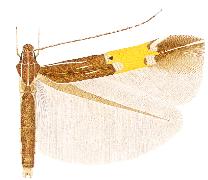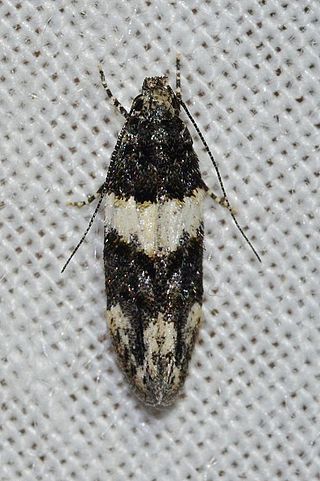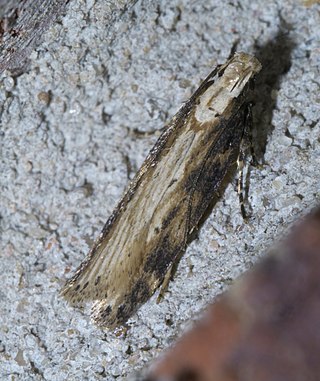
Agnippe is a genus of moths in the family Gelechiidae.
Naera is a genus of moth in the family Gelechiidae. It contains the species Naera fuscocristatella, which is found in North America, where it has been recorded from Alabama, Kansas, Louisiana, Mississippi, Tennessee and Texas.
Prostomeus is a genus of moths in the family Gelechiidae. It contains only one species, Prostomeus brunneus, which is found in Cuba and the south-eastern United States, where it has been recorded from Alabama, Florida, Mississippi and North Carolina.

Cosmopterix clandestinella is a moth of the family Cosmopterigidae. It is known from the United States.

Cosmopterix clemensella is a moth of the family Cosmopterigidae. It is known from Canada and the United States.

Cosmopterix lespedezae is a moth of the family Cosmopterigidae. It is known from the United States.

Cosmopterix magophila is a moth of the family Cosmopterigidae. It is known from the United States and the Dominican Republic.

Cosmopterix thelxinoe is a moth of the family Cosmopterigidae. It is known from Brazil and the United States.

Aristotelia roseosuffusella, the pink-washed aristotelia, clover aristotelia moth or garden webworm, is a moth in the family Gelechiidae. It is found in North America, including Alabama, Georgia, Illinois, Kentucky, Maryland, Massachusetts, Michigan, New Jersey, Oklahoma, Ontario, South Carolina, Tennessee and Virginia. The species was first described by James Brackenridge Clemens in 1860.

Battaristis concinusella is a species of moth in the family Gelechiidae. It is found in North America, including California, Delaware, Illinois, Maryland, Minnesota, North Dakota, Ohio, Ontario, Quebec, South Carolina and West Virginia.

Agnippe laudatella is a moth of the family Gelechiidae. It is found in California, United States.

Pubitelphusa latifasciella, the white-banded telphusa moth, is a moth of the family Gelechiidae. It is found in North America, where it has been recorded from Alabama, Arkansas, Florida, Georgia, Illinois, Indiana, Kansas, Kentucky, Louisiana, Maryland, Minnesota, Mississippi, Missouri, New Jersey, New York, North Carolina, Ohio, Oklahoma, Ontario, Quebec, South Carolina, Tennessee, Texas, Virginia, West Virginia and Wisconsin.

Chionodes hibiscella is a moth in the family Gelechiidae. It is found in North America, where it has been recorded from Connecticut and Illinois to South Carolina, Louisiana, Mississippi and Texas.
Agnippe biscolorella is a moth in the family Gelechiidae. It is found in North America, where it has been recorded from Illinois, Maryland, Ohio, West Virginia and Kentucky.
Agnippe evippeella is a moth in the family Gelechiidae. It is found in North America, where it has been recorded from Texas, Cuba and Puerto Rico.
Agnippe leuconota is a moth in the family Gelechiidae. It is found in North America, where it has been recorded from Illinois, Maine, Florida, Texas and Mexico.
Coleotechnites cristatella is a moth of the family Gelechiidae. It is found in North America, where it has been recorded from Kentucky.
Pseudochelaria walsinghami is a moth of the family Gelechiidae. It was described by Dietz in 1900. It is found in North America, where it has been recorded from Alabama, Arizona, Arkansas, Florida, Illinois, Indiana, Kansas, Kentucky, Maine, Mississippi, Nebraska, North Carolina, Ohio, Pennsylvania, South Carolina and Tennessee.
Untomia albistrigella is a moth of the family Gelechiidae. It was described by Vactor Tousey Chambers in 1872. It is found in North America, where it has been recorded from Alabama, Arkansas, Florida, Georgia, Illinois, Indiana, Kentucky, Louisiana, Maryland, Mississippi, North Carolina, Ohio, Oklahoma, Ontario, Pennsylvania, South Carolina, Tennessee, Texas and West Virginia.
Taygete sylvicolella is a moth in the family Autostichidae. It was described by August Busck in 1903. It is found in North America, where it has been recorded from Illinois, Maine, New York, Ohio and South Carolina.





